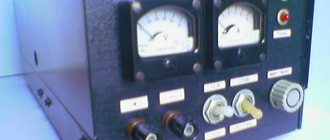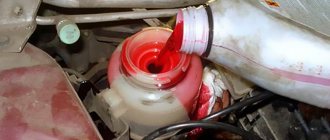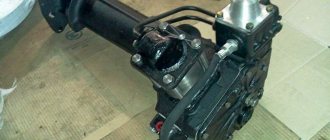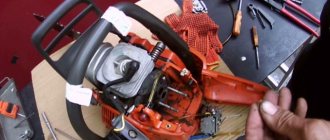Diesel engines are significantly different from gasoline engines. But the problems with them are almost the same as with gasoline units. After reading car forums, you can see many different topics where certain problems are discussed. But you can especially often see topics where car enthusiasts complain that diesel engines periodically emit black smoke from the exhaust. Let's figure out what the problem is and why this phenomenon occurs. Let's also see how this problem can be solved.
Making a diagnosis based on exhaust colors
Diesel engines, as well as gasoline engines, can have exhausts of various colors. More often it is white, bluish, gray and black smoke.
Let's start with white. Often white is the name given to smoke with a bluish tint. This happens when the turbine is destroyed and the lubricant gets directly into the intake tract. In such a situation, bluish smoke pours out of the chimney. But an inexperienced car enthusiast will easily mistake it for white smoke. And if you smell it, then it’s immediately clear and understandable what the reason for its appearance is.
Many people have burned vegetable oil or butter in a frying pan at least once in the kitchen. The smell is about the same. This smoke can also be confused with steam, which is more often observed in the winter months from the exhaust of not only diesel cars. It's all because of the water that appears as a result of combustion.
Later, after the engine has warmed up, the steam will not be noticeable, although it will not go away. This can be easily checked. You just need to place your palms near the exhaust. The palm will be slightly damp. This steam causes significant inconvenience when tuning the engine, especially in winter. For high-quality settings, you have to warm up the unit for a long time. And in cold weather the adjustment may not be possible at all.
Consequences of soot formation
With increased soot formation in a diesel engine, the diesel particulate filter is usually the first to fail, which leads to the need to replace it. Subsequently, the soot gets into the oil, which circulates throughout the engine. The oil channels quickly become clogged, which is why the oil cannot effectively remove heat from engine parts and they overheat.
First, plaque forms on the piston rings (they become coked). Then all the filters installed in the car quickly become clogged with dirt and lose their properties.
Reducing the flow of fuel channels reduces the amount of incoming oil to lubricate parts, which is why they are subject to increased wear. Operating the engine at elevated temperatures will eventually lead to burnout of valves and pistons. Replacing these parts is one of the most expensive procedures when servicing a car.
When mixing fuel and engine oil, the viscosity of the latter is greatly reduced and in this state the oil is not able to protect parts from wear during operation. This can be determined visually by removing the oil dipstick from the engine. If, even at subzero temperatures, engine oil drips from the dipstick and smells like diesel fuel, this is a direct indication of the need for urgent repairs.
Repair
If you find a crack in the cylinder head, then we can only recommend replacing the head. However, prices... Therefore, many car enthusiasts do not disdain contract details. These are used parts from Europe.
Cracked cylinder heads can be repaired, but we will not recommend this technology, because during such repairs a hole is drilled that will fit into the crack, and then a copper rod is pressed into the hole. There will be no blow-by, but one of the cooling valves will be blocked halfway. Such a head will have a significantly reduced resource.
Anti-smoke additives - a panacea or a waste?
Various auto chemical brands offer special additives to reduce oil consumption. They form a film on the rubbing parts of the engine that protects them from wear and fills existing microcracks. The use of additives replaces the decoking of piston rings, cleaning them from dirt. Manufacturers promise all this, but is it really so?
On auto forums you can find conflicting opinions about anti-smoke additives. Some auto mechanics note that the use of such products makes it difficult to overhaul the engine. The engine parts are covered with an oil layer, which is very difficult to completely wash off. Individual parts that could simply be cleaned have to be replaced, which means repairs are more expensive.
The additive only slightly extends the life of the engine before repair, but does not guarantee its trouble-free operation.
Blue smokes
For those with smoke pouring out of the exhaust pipe, diesel made them worry at the sight of blue smoke.
Blue, and on some engines it can be gray, on a working engine it is often caused by late injection. This problem has been mentioned more than once; many car enthusiasts have managed to discuss this topic up and down.
Experts say blue smoke is not scary. In most cases, the problem of late injection is associated with the natural process of wear of the fuel injection pump, naturally, if no one touched the pump.
Other causes of smoke in diesel engines
- Malfunction of the CCVV (crankcase ventilation valve). This problem is typical for BMW cars. When accelerating hard, the diesel produces thick white smoke. Replacing the valve solves the problem.
- Engine oil overheating. The problem manifests itself under extreme loads on the engine (full weight load, prolonged ascent) - then thick white smoke pours out of the muffler. The solution is to replace the oil with a higher quality one and not subject the engine to overload.
- Worn or hardened valve seals. The problem is typical for domestic cars with a diesel engine. It manifests itself as an abundant emission of white-blue smoke in the first seconds after starting the engine. As it warms up, the smoke goes away. The solution is to replace the valve stem seals.
Causes of Blue Smoke
The high pressure fuel pump in our conditions works as follows. The set of parts in this assembly constantly rotates, works, and rubs. And lubrication is provided by the pumped diesel engine. As long as the diesel engine is moderately oily, the pump can operate in this mode for a very long time. But when cold weather sets in, winter diesel fuel is poured into diesel fuel tanks. Everything about it is excellent, but there are no lubricating fractions at all. Well, or almost absent. All its fat content, along with various paraffins, was removed at the oil refinery.
So, when winter comes, most diesel injection pumps operate without lubrication and are subject to severe wear. Because of this completely natural, but already too rapid and increased wear, the injection advance is reduced. Diesel fuel stops heating and the cylinder stops working normally. The engine jerks and shakes. Fuel that does not have time to burn ends up turning into blue smoke. Some engines produce black smoke from the exhaust. If the engine is warmed up, then it will stop smoking, or at least the amount of exhaust will decrease. In this case, the fuel has time to warm up and ignite.
If the power unit has low compression characteristics, then the temperature in the combustion chambers is lower than necessary. And the fuel will not ignite. If the unit is equipped with a pair of cylinders with good compression, the cylinder with less compression will not work.
This picture often happens in parking lots. The cars are trying to start, and the entire area is filled with blue smoke. But sometimes diesel produces black smoke from the exhaust pipe. After warming up, the smoke will disappear. After all, the temperature in the engine is rising, and the temperature increase even in worn-out cylinders will be enough for ignition.
A case from one's life
Mechanics tell one story on this topic. The cylinder head gasket on the unit was replaced. After the engine was assembled, we discovered strong shaking at idle. After a couple of kilometers these vibrations stopped, and after a couple of minutes of idling the shaking reappeared. Mechanics analyzed this situation and found out that the new gasket was slightly thicker. Until the diesel engine warmed up to operating temperature, it did not work smoothly.
So, the main cause of blue smoke is late fuel injection and low compression performance. Many modern engines have a device that performs injection a little earlier. Cars work harder, but the fuel in the cylinders heats up and burns without smoke, that is, at all. Then the unit heats up, the coolant heats up the actuators, and they return the injection advance piston to its rightful place. The motor runs smoother and more pleasant.
Why does black smoke come out of a diesel exhaust pipe?
A larger volume of supplied fuel is usually a signal of either incorrect adjustment of the fuel injection pump, wear of the injectors, or wear of the speed controller in the pump.
Any fuel pump is equipped with a special adjusting screw. It is used to adjust the volume of supplied fuel. With this screw you can only roughly adjust the volume. If this screw is tightened, then the volumes increase. And where there is an increase in volumes, there is also an increase in idle speed. But the speed can be significantly reduced. Then you can increase the power. But black smoke from the exhaust pipe will continue to drive diesel. If the adjusting screw on the fuel injection pump is screwed in even more than it should be, the unit will practically stop reducing speed.
The saddest thing
One of the saddest breakdowns that beset diesel owners is the inevitable wear and tear of the fuel pump. As already mentioned, the guts inside the pump operate without lubrication. While diesel still lubricates something in summer, in winter it doesn’t. And domestic fuel is generally of low quality. This is where the insides of the pump wear out.
When the gas pedal is pressed very sharply, for example, in order to quickly move off, the injection pump lever is switched to increase the volume of fuel supply. This lever will rest on the support. And the position of this very support has already been adjusted by the regulator. Therefore, it will not be possible to increase the volume too sharply. So, by pressing the pedal, the driver only wants to give a larger volume of fuel. And it’s not at all a fact that this will lead to an increase in turnover. This directly depends on how worn the speed controller is. If it is in normal condition, then the car will start with gray smoke. If the wear is large, then the diesel will spit out black smoke from the exhaust pipe in a large cloud.
What does the KamAZ exhaust indicate?
Car exhaust, an indicator of the condition of the power plant. As already mentioned, the KamAZ diesel engine does not smoke under normal conditions. Otherwise, analysis of emissions (smoke color) will answer the question about the condition of the motor. The indicator will indicate the exact cause of the breakdown, the degree of wear and condition of the components. Damage to injectors and fuel pressure pump.
Exhaust is the remains of unburned fuel coming out in the form of gas. Visually, the emission products are visible at sub-zero temperatures, then the smog is presented in the form of steam.
When KamAZ operates, there is exhaust of the following colors:
- White issue, with an admixture of black and gray tones;
- Blue edition, with an admixture of gray tone;
- Black exhaust, with soot emissions.
About lack of air
Also, dark gases from the pipe can sometimes be caused by a lack of air. But in this case, the exhaust will not be black, but rather gray or dark gray. At the same time, a decrease in power is observed.
This can be caused by a clogged air supply filter. This is by no means a rare case, and it happens to everyone from time to time. It has been proven not 10 or 100 times by bitter experience that only 15 minutes in a traffic jam in front of a KamAZ truck with black smoke coming out of the exhaust pipe is enough. The diesel is burning, and the new filter of the one standing behind can now be thrown into a landfill. But this happens if KamAZ’s fuel system is incorrectly adjusted, although no one has it adjusted.
Also, a lack of air can be observed due to incorrect operation of the EGR and throttle valve, incorrect clearances in the timing valves. Also among the reasons may be incorrectly set gas distribution marks, turbine malfunctions.
When the car is equipped with a turbine and you see black smoke from the exhaust pipe of a diesel turbo, then it is worth checking the boost. Most likely, that's the problem. It is also worth looking for cracks in the fuel or air system pipes.
One of the car owners poured fuel system cleaner into the car. After driving for a while, at high speeds when driving uphill, the car began to puff out black smoke. But after puffing a little, the smoke disappeared and has not appeared since then. At the same time, he checked all the above reasons. He believes the additive helped. The car didn't smoke anymore. So, perhaps the cause of the smoke in this case may simply be soot from the fuel system, especially if the diesel engine is equipped with a converter. Sometimes the filter needs to be cleaned from time to time.
It would be better if he was silent or why Kuznetsov is smoking
The captain of Admiral Kuznetsov explained why his ship was smoking heavily: This is not a sign of any malfunction. In fact, ships of NATO countries also blow smoke. Maybe their smoke doesn't go as high into the sky as ours does. But that’s why “Admiral Kuznetsov” has the highest chimney in our entire fleet! When the world and Russian blogosphere discussed the passage of a flotilla led by the aircraft carrier Admiral Kuznetsov across the English Channel, the most heated debate on the Internet was caused by the thick smoke - both dark and light in color - that the aircraft carrier emitted. The Russian press reacted instantly and this particular picture went viral on blogs and Rostv (NTV): USS Freedom (LCS-1) There were also smoking Mistrals and some kind of Spanish aircraft carrier from World War II
Tags:
Another reason for black smoke from a diesel exhaust pipe
One of the owners of a diesel car suddenly began to smoke. During the autopsy, nothing intelligible could be found. But after reading all kinds of forums and talking with other diesel owners, it turned out that the problem was in the ignition.
After opening it again, a control valve was found on the ignition unit. He was advised to hit the adjusting bolt. After that the car stopped smoking. It turned out that it was the ignition angle solenoid valve.
When the ignition is turned on, a working sensor crackles. What to do if black smoke appears from the exhaust pipe (diesel)? No matter what ignition it appears, the sensor should be removed. If the engine has stopped smoking and the car is running smoothly, then it’s time to change this element.
Black smoke and cold start
A study of the forums showed that many people complain about smoke when starting a diesel engine when cold. Some people say that this is a fuel injection pump, but more experienced car enthusiasts say that this is not so.
It is believed that this phenomenon is quite normal. Usually it is short-lived. This can be explained by the fact that during a cold start, an over-rich mixture is supplied to the cylinders. Hence the black smoke from the exhaust pipe. Diesel often does this when cold. Therefore, there is no need to panic about this.
The situation with the Kia Sorento
Let's give a specific example. One of the owners of this car produces thick, black smoke when pressing the accelerator pedal. When moving, the car is very reluctant to gain momentum.
A scan was carried out for possible errors in the electronic system, but there were no errors. Analysis of the operating parameters also did not give the desired result. At first glance, there is simply no defect. The balance of the injectors is in normal condition, no serious deviations were noticed, the turbine produces a normal level of pressure, but the Kia Sorento diesel still produced black smoke from the exhaust pipe. When measuring the readings, we thought about the USR. This is a valve that regulates exhaust gases.
After examining it, they discovered serious soot deposits behind the throttle valve. After removing the exhaust gas pipe, soot and oil were also found in the intake tract. In the end everything was removed and cleaned. But a more detailed examination of the valve itself revealed damage to its seat. As a result, the valve was replaced.
As a result, there is no smoke, and the car drives noticeably better.
Carrying out complete and comprehensive diagnostics
Thanks to YaMZ engine diagnostics, it is possible to identify possible malfunctions and breakdowns. The procedure is carried out during maintenance or repair work to determine the current condition. If the engine stops working, specialists perform an assessment of the parameters and an external inspection of the power unit.
They study the following parameters:
- engine completeness;
- tightness of the oil pan, connections and pipelines;
- presence of deformation (this could be dents, cracks, breakages, or other damage);
- condition and integrity of external fastenings;
- condition of components and additional engine components.
If the engine is in working condition, it is started at idle. While driving, you can determine the nature of the launch, throttle response, and operation at low speeds. Additionally, economic indicators and work dynamics are checked. In case of deviations, timely repairs and replacement of parts that have failed are required.
During diagnostics, knocking and extraneous noise may be detected. If the temperature of water and oil inside the engine deviates, it cannot be operated
Particular attention is paid to the technical condition of parts of the cylinder-piston group











